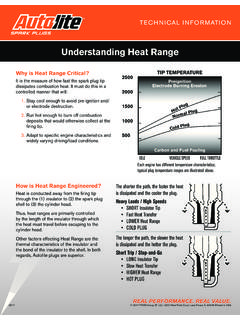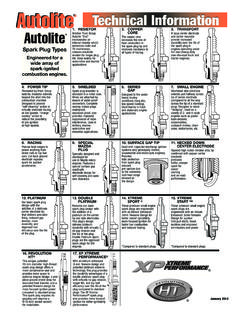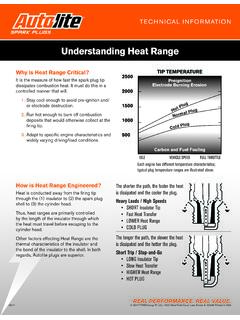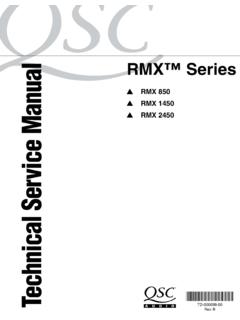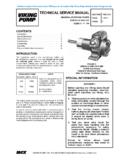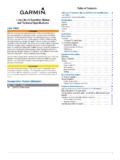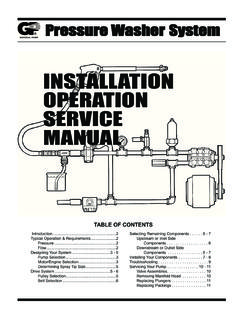Transcription of Autolite Technical Training Manual
1 SPARK PLUGTECHNICAL Training Manual 2017 FRAM Group IP, LLCTABLE OF CONTENTSA utolite History 3 Basic Engine Operation (4-stroke/2-stroke) 4 Requirements for Engine Operation 6 Ignition System Basics 8 Types of Ignition Systems 9 How Spark is Generated 14 Ignition System Advance/Retard 15 The Role of the Spark Plug 16 Spark Plug Heat Ranges 19 Changes in Voltage Requirements 20 Anatomy of a Spark Plug 23 Types of Spark Plugs 24 How to Read Autolite Spark Plug Numbers 25 Selling the Right Spark Plug 28 Installation Guide 29 Service Life & Misfiring 32 Troubleshooting 34 Frequently Asked Questions 383 Founded in 1911 to produce horse-drawn carriage lamps.
2 The Electric Autolite Company was a thriving automotive parts manufacturer by the 1930s. The company s signature product was developed in 1935 when a new laboratory was equipped and staffed specifically to engineer the first Autolite spark plug. Success came quickly, and soon Autolite was supplying spark plugs and ignition components to original equipment manufacturers such as Chrysler, Studebaker, Packard and Willys. 1936: Autolite produces its first spark plug in Fostoria, Ohio 1948: Autolite introduces the Resistor spark plug 1956: Autolite produces first Power Tip spark plug 1976: Autolite produces first Suppressor spark plug 1987: Autolite produces first Platinum spark plug 2003: Autolite produces the first High Thread (HT) spark plug for Ford Triton engines 2005: Autolite produces first mm finewire XP Xtreme Performance spark plug 2007: Autolite produces its 10 billionth spark plug 2007.
3 Autolite introduces coil-on-plug insulator boots, and Xtreme Sport and Xtreme Start premium small-engine spark plugsToday, the Autolite brand continues to grow, providing the automotive aftermarket and OEMs with high-quality ignition products, including spark plugs, ignition wire sets and coil-on-plug boots. State-of-the-art process control and automated inspection helps ensure that quality Autolite products meet rigorous internal and customer is a unit of the UCI/Fram Group, which also manufactures and markets: FRAM oil, air, transmission and fuel filters Prestone antifreeze/coolant and car care products Airtex fuel pumps Wells vehicle electronics ASC water pumpsAUTOLITE BRAND HERITAGE4 FOUR-STROKE ENGINES This most common type of engine, found in cars, trucks and many motorcycles, goes through four strokes or cycles of operation:1.
4 Intake As the piston moves downward, the intake valve opens, and a mixture of air and gasoline vapor (air/fuel) is sucked into the Compression As the piston reaches its lowest point (bottom dead center) and then moves back upward, the intake valve closes, and the air/fuel mixture is Power When the piston is near the top of its travel (top dead center), the spark plug fires, which ignites the air/fuel mixture. The pressure from the burning fuel forces the piston Exhaust As the piston then moves back upward, the exhaust valve opens, and the burnt gases are pushed out of the cylinder.
5 The cycles then Engine Advantages: Durable and efficient. Can be tuned for a combination of high power, low fuel consumption and low Engine Disadvantages: Requires complex control systems to produce the optimal combination of power, fuel consumption and are two basic types of gasoline-powered piston engines: Four-stroke and two-stroke. BASIC ENGINE OPERATION12345 BASIC ENGINE OPERATIONTWO-STROKE ENGINES Two-stroke engines are found in many motorcycles as well as devices such as chain saws and weed cutters. This type of engine only has two strokes or cycles of operation:1. Intake/Compression When the piston is at the bottom of its downward travel (bottom dead center), the intake port is uncovered.
6 Air and a mixture of gasoline and oil flow into the cylinder. As the piston moves upward, this mixture is Power/Exhaust When the piston is near the top of its travel (top dead center), the spark plug fires, which ignites the mixture. The pressure from the burning fuel forces the piston downward. As the piston moves downward, it uncovers the exhaust port, which allows burnt gases to Engine Advantages: Powerful, lightweight and simple in construction. Two-stroke engines produce power once every revolution versus four-stroke engines, which produce power every other revolution. Two-Stroke Engine Disadvantages: Requires a mixture of oil and gasoline to operate.
7 Lack of a dedicated lubrication system means two-stroke engines do not last as long as four-stroke engines. Difficult to control exhaust FOR ENGINE OPERATIONW hile there are many things that can affect engine performance, these are the most basic requirements for a gasoline engine to operate:1. Air/Fuel Mixture Gasoline vapor must be mixed with air in a relatively precise ratio in order for an engine to run properly. An air/fuel ratio that is too rich too much gasoline may ignite, but will create excess exhaust emissions and will shorten the life of many engine components.
8 An air/fuel ratio that is too lean too little gasoline may not ignite, or may ignite but not create enough power. The ideal air/fuel ratio for complete combustion and good power is called a stoichiometric ratio about parts of air to 1 part gasoline. During the course of an engine s operation, however, the air/fuel ratio will vary: A higher ratio of fuel to air will be required during acceleration or heavy demands on the engine (called high-load situations) A lower ratio of fuel to air can be used during deceleration or light-load situations Modern engines with computer-controlled fuel injection systems can vary the air/fuel ratio very precisely for a wide range of driving conditions in order to achieve strong performance, low fuel consumption and low Compression Compressing the air/fuel mixture into a smaller, denser volume generates more power when the mixture is ignited.
9 An engine s compression ratio is measured by comparing the maximum volume of the cylinder to the minimum volume of the cylinder as the piston moves up and down: Compression ratio = Cylinder volume with the piston at its lowest downward position (bottom dead center) divided by cylinder volume with the piston at its highest upward position (top dead center) The compression ratio on passenger-car engines can be as low as :1 or as high as :1. The higher the compression ratio, the greater the combustion pressure, which will produce more power. However, higher compression ratios require higher-octane gasoline, and often need more complex fuel and ignition system controls to prevent damaging engine High-Voltage Ignition Spark is essential to an engine s operation.
10 The electrical spark that is generated across the gap of a spark plug s electrodes is what ignites the air/fuel mixture. This explosive combustion of gasoline vapor forces the piston downward, which turns the crankshaft, generating power that ultimately turns the wheels. In a modern engine, thousands of volts of electricity are required for complete combustion. Equally as important as the strength of the spark is its timing ignition should occur near each piston s top dead center position. This ignition timing is not constant, however, and must vary with engine speed and load. More information on this subject will be provided later in this FOR ENGINE OPERATION81234 All ignition systems comprise the following components or functions: 1.
